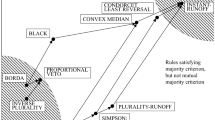Abstract
The Single Transferable Vote (STV) is an attractive way of achieving representation that is proportional in terms of whatever characteristics of candidates voters value. Increasingly sophisticated methods of implementing STV have been advanced to overcome identified limitations of earlier methods. But every refinement comes at a cost of increased difficulty of understanding the vote-counting algorithm and increased cost of undertaking the count. This paper uses votes from actual elections to provide evidence about the frequency with which the choice of a particular STV method affects the outcome, and about the type of difference that different methods make. The most sophisticated STV method is CPO-STV, the comparison of pairs of outcomes by STV. This method avoids sequential exclusions and therefore overcomes the limitations of previous methods, that a paucity of votes in the early stages of a count can lead to the exclusion of a candidate who is the consensus choice of voters whose preferred candidates will be excluded at later stages of the count.
Similar content being viewed by others
References
Dummett, M. (1984). Voting procedures. Oxford: Clarendon Press.
Hill, I.D. (1988). Some aspects of elections — to fill one seat or many. Journal of the Royal Statistical Society, Series A (General), 151: 243–275.
Hill, I.D., Wichmann, B.A. and Woodall, D.R. (1987). The single transferable vote by Meek's method. Computer Journal 30: 277–281.
Hoag, C. and Hallett, G. (1926). Proportional representation. New York: Macmillan.
Meek, B. (1969). Une nouvelle approche du scrutin transférable. Mathématiques et Sciences Humaines 25: 13–23.
Newland, R. and Britton, F. (1973, 1976). How to conduct an election by the single transferable vote. London: Electoral Reform Society of Great Britain and Ireland (1st ed., 1973; 1nd ed., 1976).
Tideman, N. (1995). The single transferable vote. Journal of Economic Perspectives 9: 27–38.
Warren, C.H.E. (1983). Counting in STV elections. Unpublished paper. 19 Rectory Road, Farnborough, Hants. GU14 7BU, UK.
Author information
Authors and Affiliations
Rights and permissions
About this article
Cite this article
Tideman, N., Richardson, D. Better Voting Methods Through Technology: The Refinement-Manageability Trade-Off in the Single Transferable Vote. Public Choice 103, 13–34 (2000). https://doi.org/10.1023/A:1005082925477
Issue Date:
DOI: https://doi.org/10.1023/A:1005082925477



